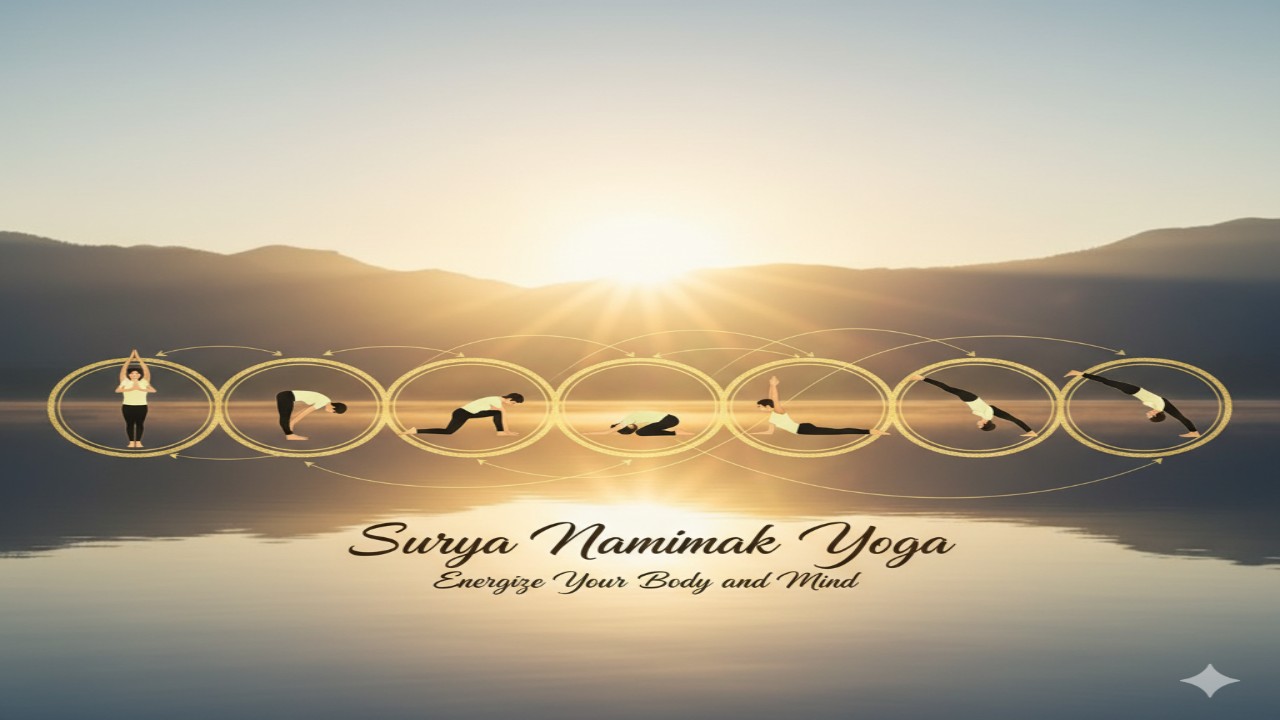Surya Namaskar, commonly known as Sun Salutation, is one of the most revered and comprehensive yoga practices in existence. This ancient sequence of twelve powerful yoga poses combines physical exercise, breath control, and meditative awareness into a single, flowing routine. More than just a workout, Surya Namaskar represents a complete mind-body practice that has been performed for thousands of years as a way to honor the sun and cultivate inner vitality.
Whether you’re a complete beginner or an experienced yogi, Surya Namaskar offers profound benefits that extend far beyond the yoga mat. This complete guide will explore everything you need to know about this transformative practice.
What is Surya Namaskar?
Surya Namaskar is a sequence of twelve interconnected yoga postures performed in a continuous flow. The term itself comes from Sanskrit, where “Surya” means sun and “Namaskar” means salutation or greeting. This practice originated in ancient India as a ritualistic way to worship the sun, which was considered the source of all life and energy.
The sequence is designed to stretch, strengthen, and energize the entire body while synchronizing movement with breath. Each position counteracts the one before, creating a balanced workout that affects different muscle groups and body systems. The practice can be performed at any time of day, though traditionally it’s done at sunrise facing east to absorb the sun’s energy.
The Twelve Poses of Surya Namaskar
1. Pranamasana (Prayer Pose)
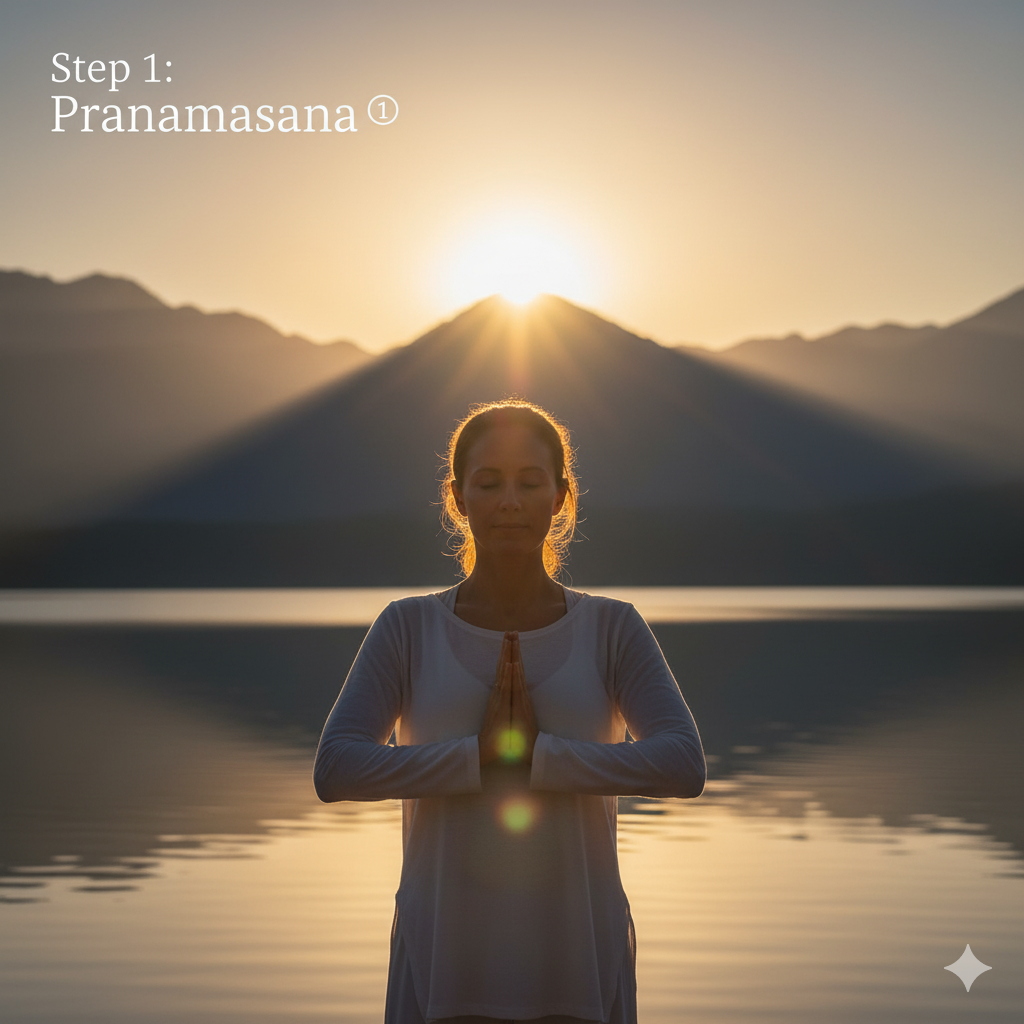
Stand at the edge of your mat with feet together, weight evenly distributed. Bring your palms together in front of your chest in a prayer position. Relax your shoulders and take deep, conscious breaths to center yourself.
2. Hastauttanasana (Raised Arms Pose)
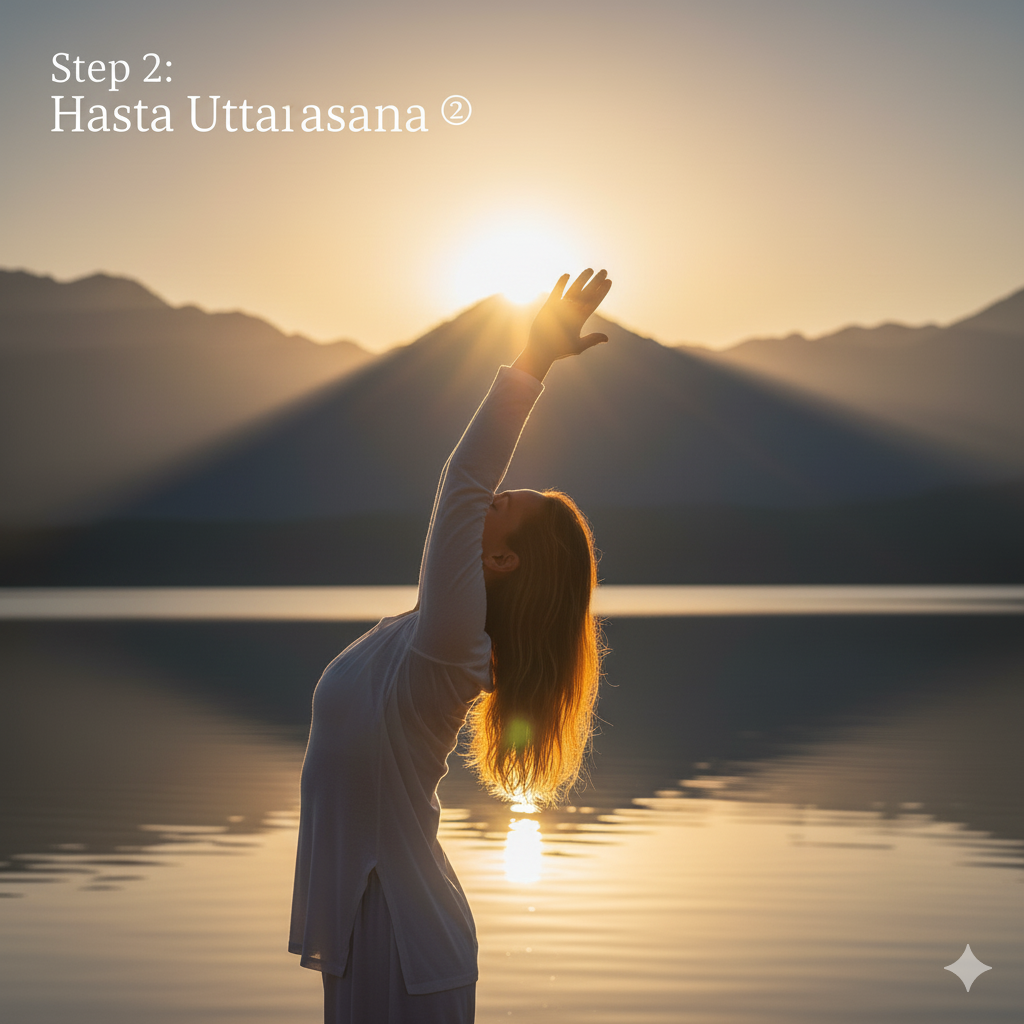
Inhale deeply and lift your arms up and back, keeping them shoulder-width apart. Gently arch your back and push your pelvis forward, creating a full-body stretch from heels to fingertips.
3. Hastapadasana (Standing Forward Bend)
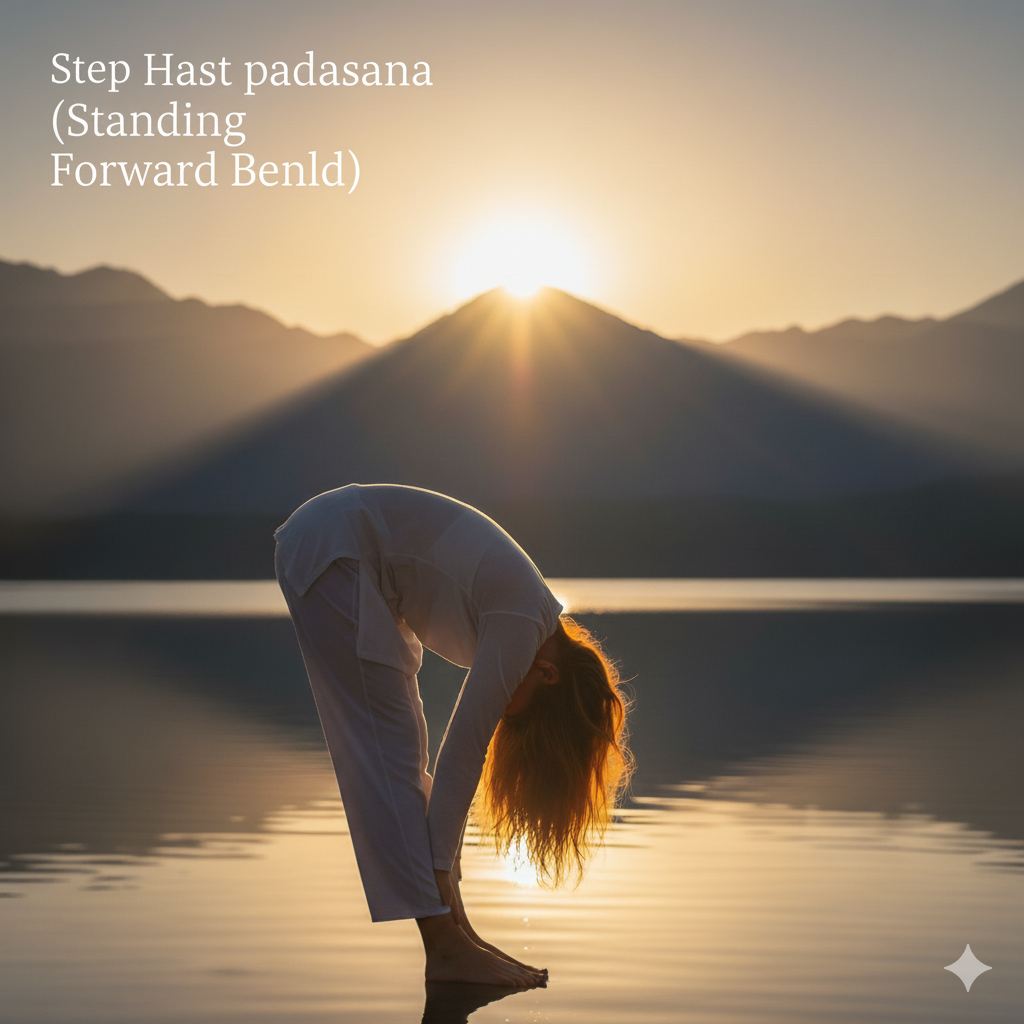
Exhale and bend forward from the waist, keeping your spine straight. Bring your hands down to the floor beside your feet, aiming to touch your knees with your forehead. Beginners can bend their knees slightly.
4. Ashwa Sanchalanasana (Equestrian Pose)
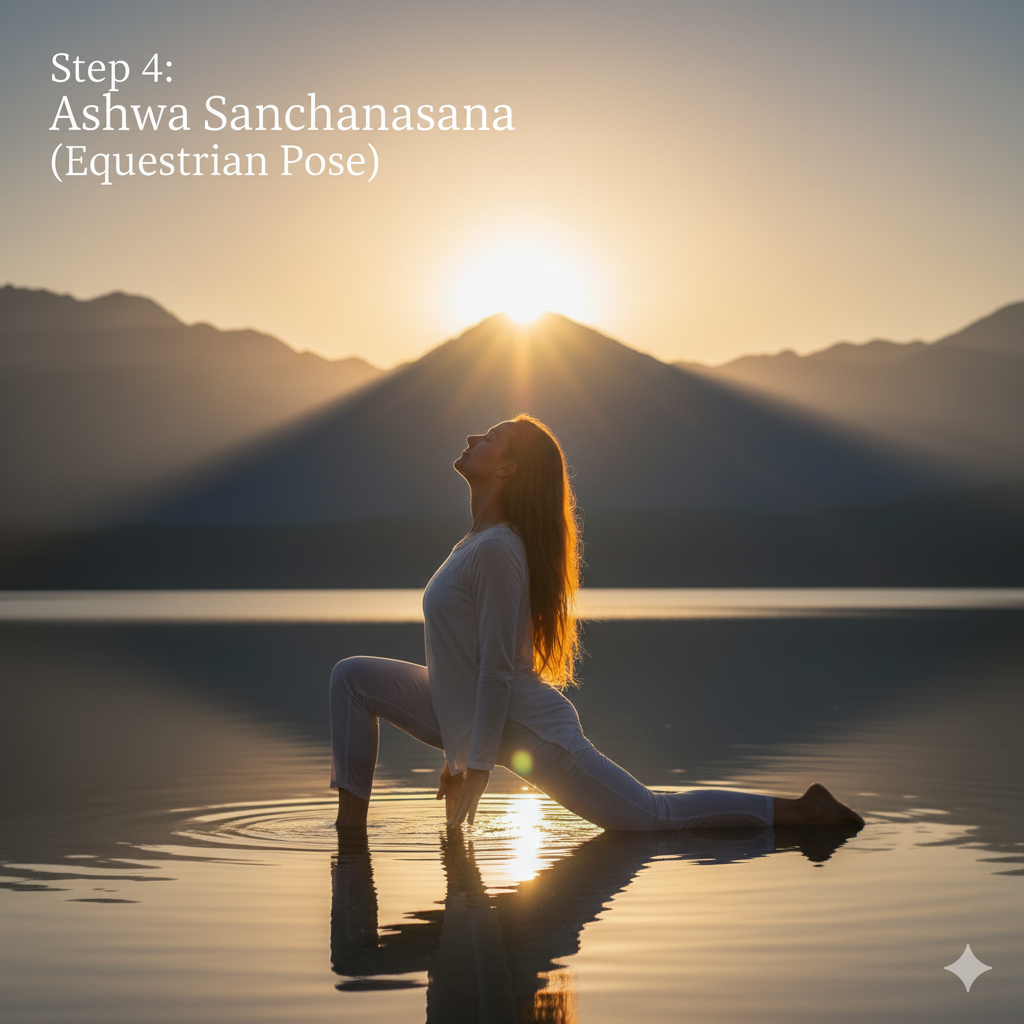
Inhale and extend your right leg back as far as possible, dropping your knee to the ground. Keep your left foot between your hands, with the knee bent. Look up and arch your back slightly.
5. Dandasana (Stick Pose)
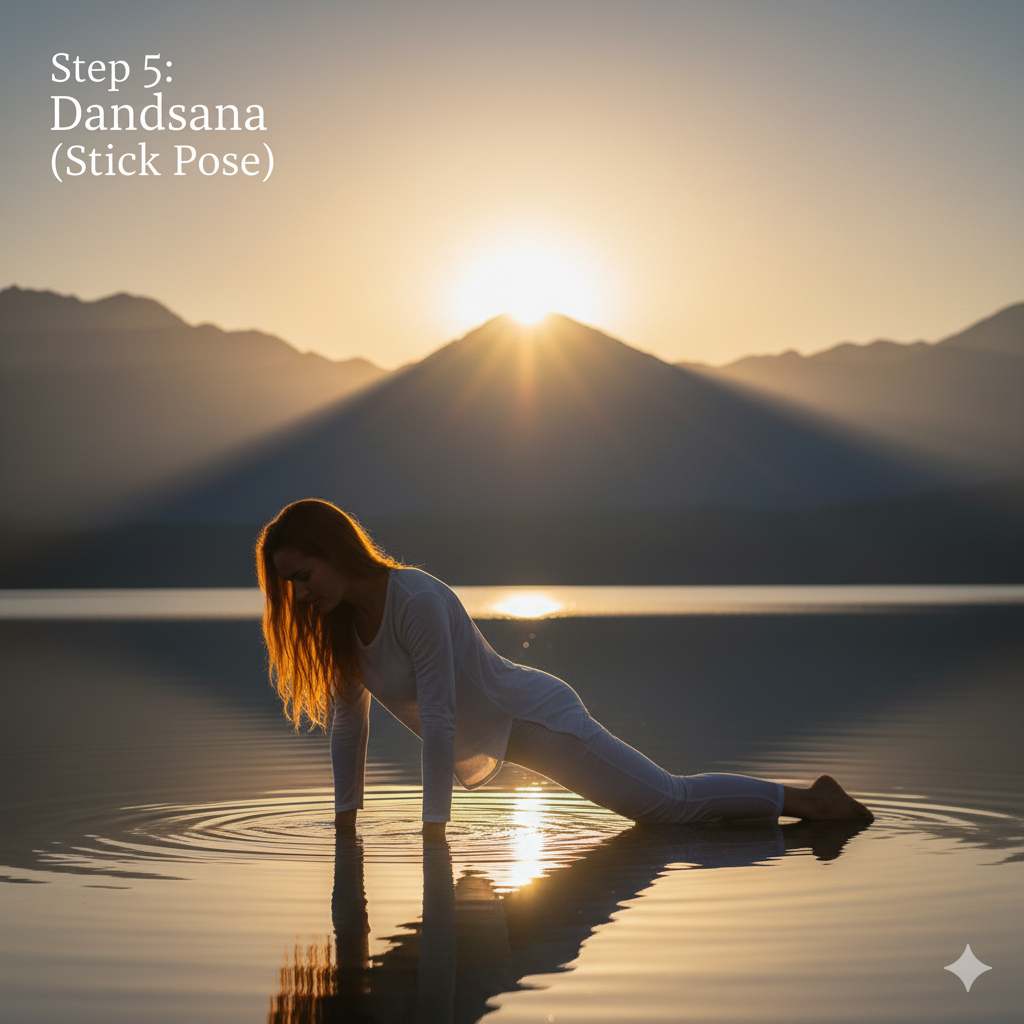
Hold your breath and bring your left leg back to meet your right, forming a straight line from head to heels. Keep your arms perpendicular to the floor, creating a plank position.
6. Ashtanga Namaskara (Salute with Eight Parts)
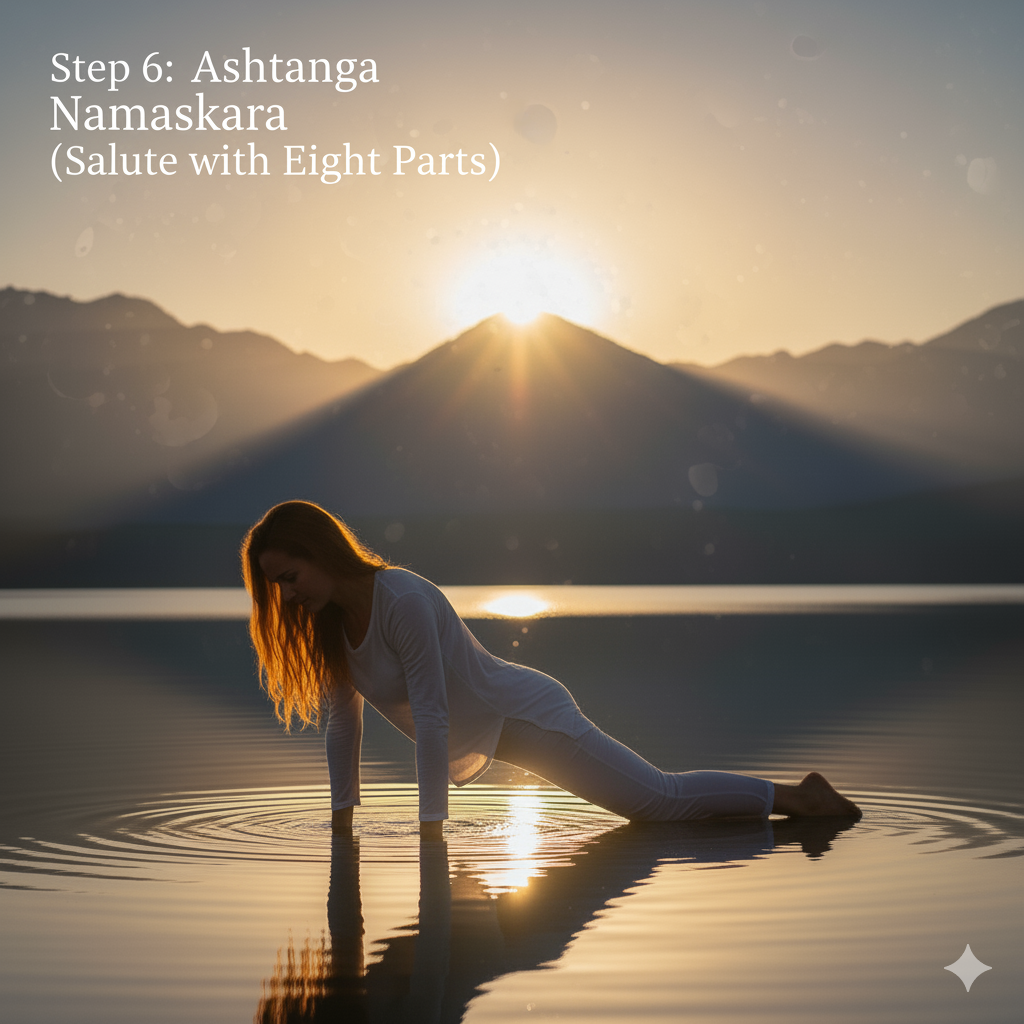
Exhale and gently lower your knees, chest, and chin to the floor while keeping your hips slightly raised. Eight parts of your body touch the ground: two feet, two knees, two hands, chest, and chin.
7. Bhujangasana (Cobra Pose)
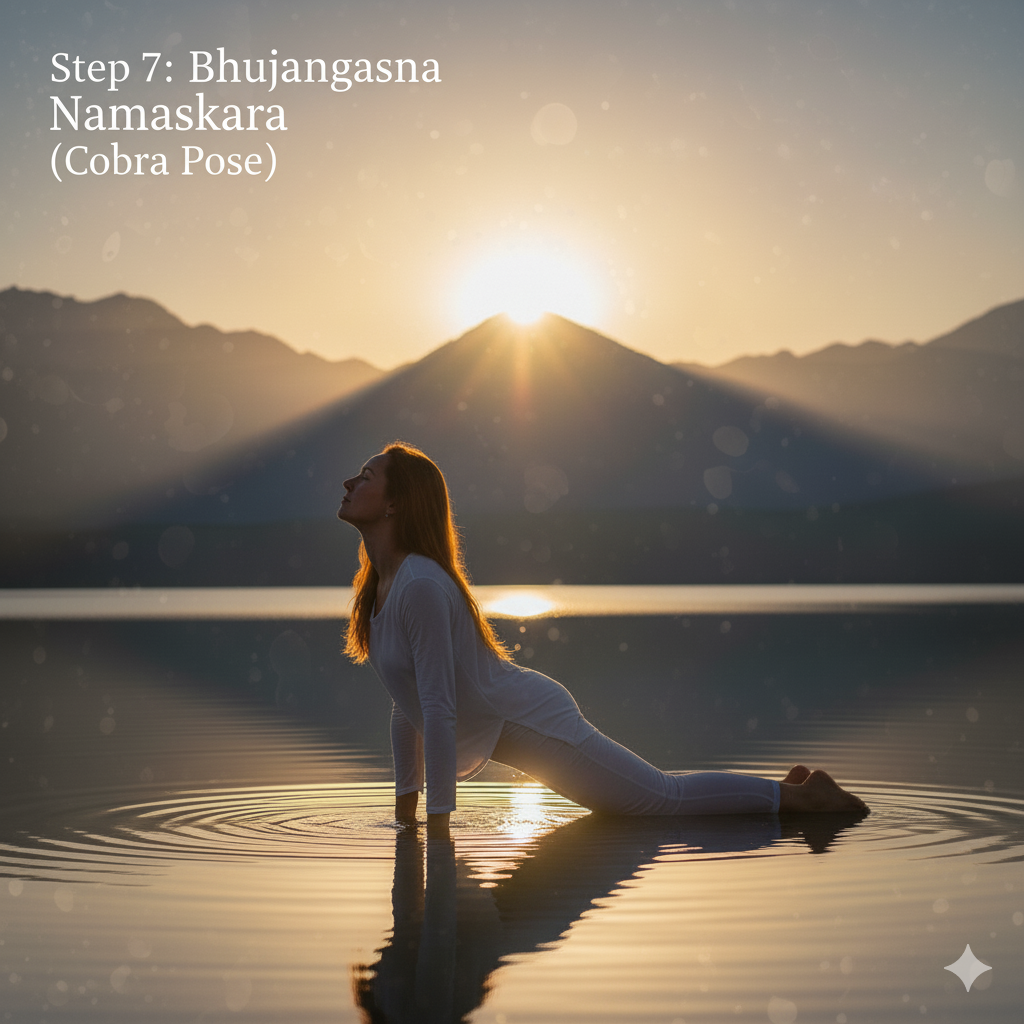
Inhale and slide forward, raising your chest up into a cobra position. Keep your elbows bent and shoulders away from your ears. Look upward while keeping your legs together and feet pointed.
8. Adho Mukha Svanasana (Downward Facing Dosg)
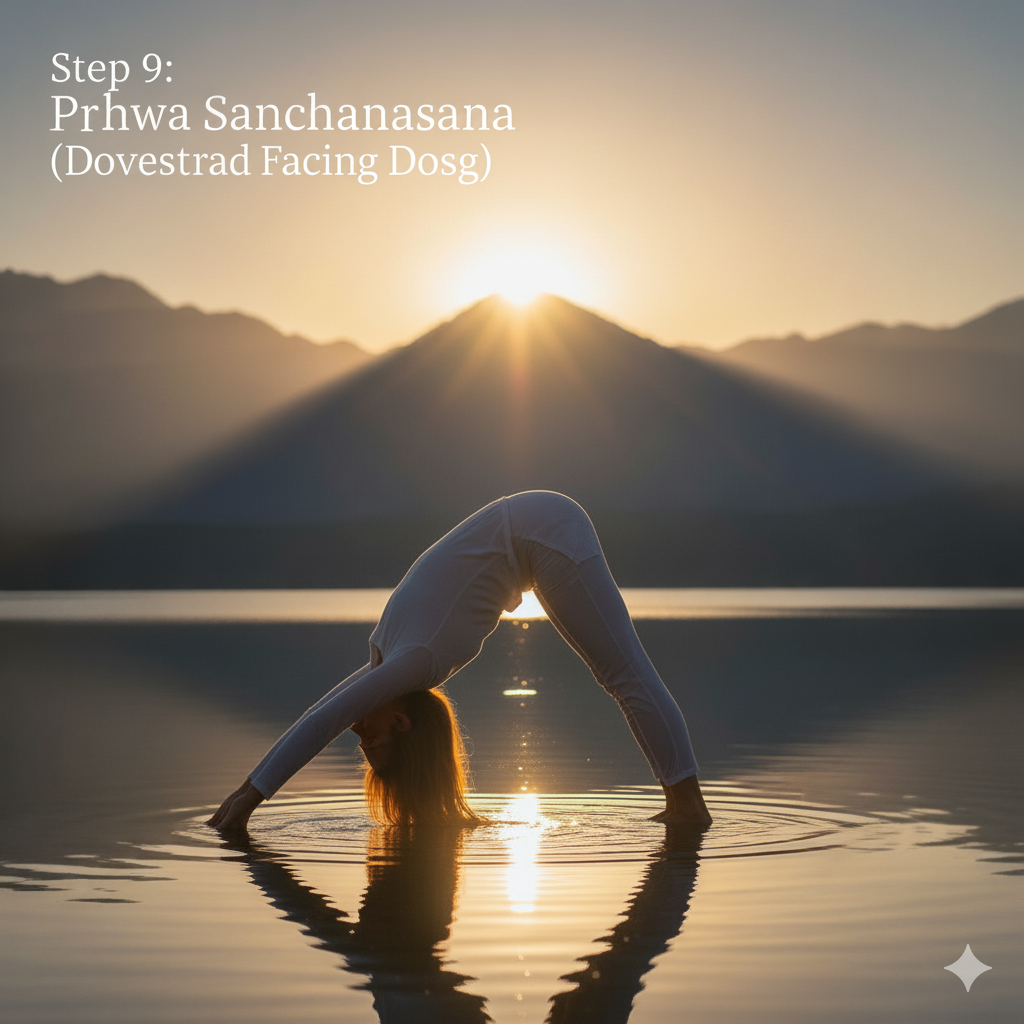
Exhale and lift your hips up toward the ceiling while keeping your hands and feet planted. Form an inverted V-shape with your body. Try to press your heels toward the floor and straighten your knees.
9. Ashwa Sanchalanasana (Equestrian Pose)
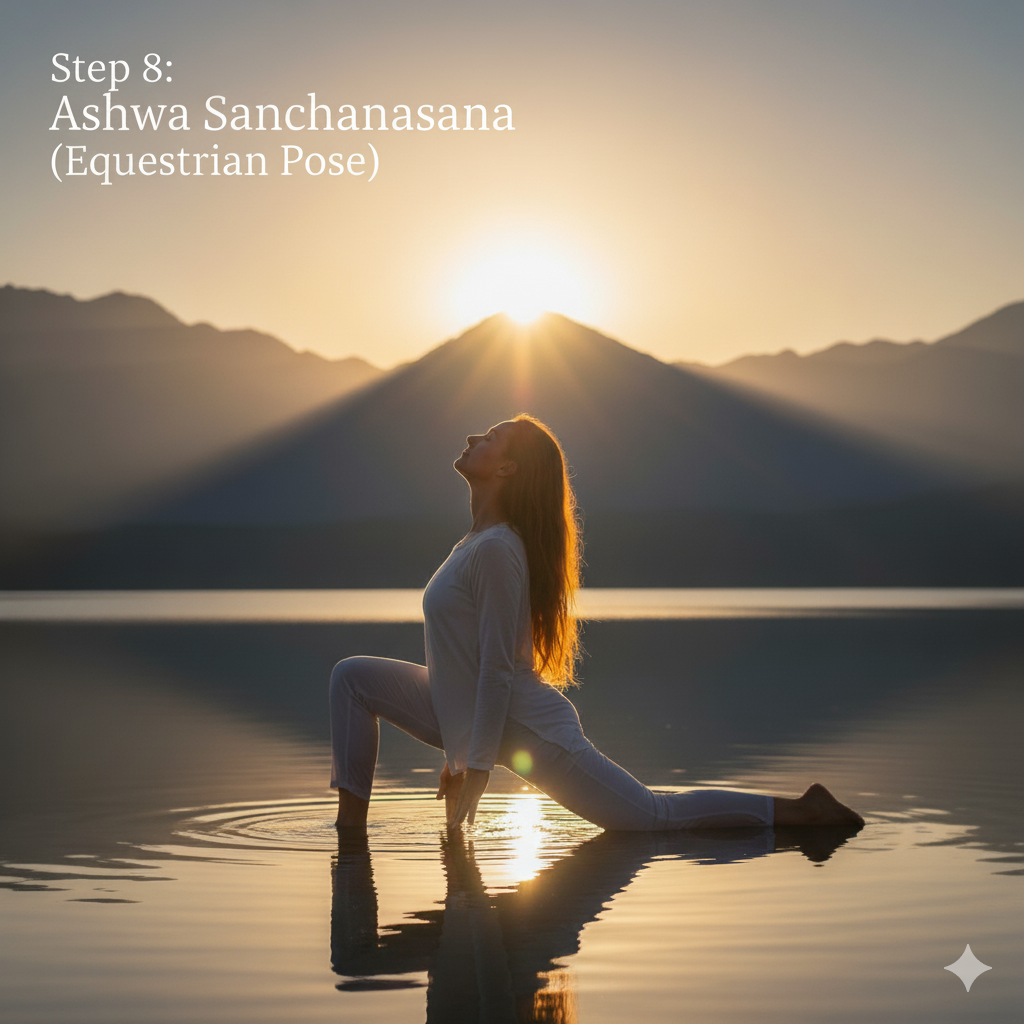
Inhale and bring your right foot forward between your hands, dropping your left knee to the ground. Return to the same position as step 4, but with the opposite leg forward.
10. Hastapadasana (Standing Forward Bend)
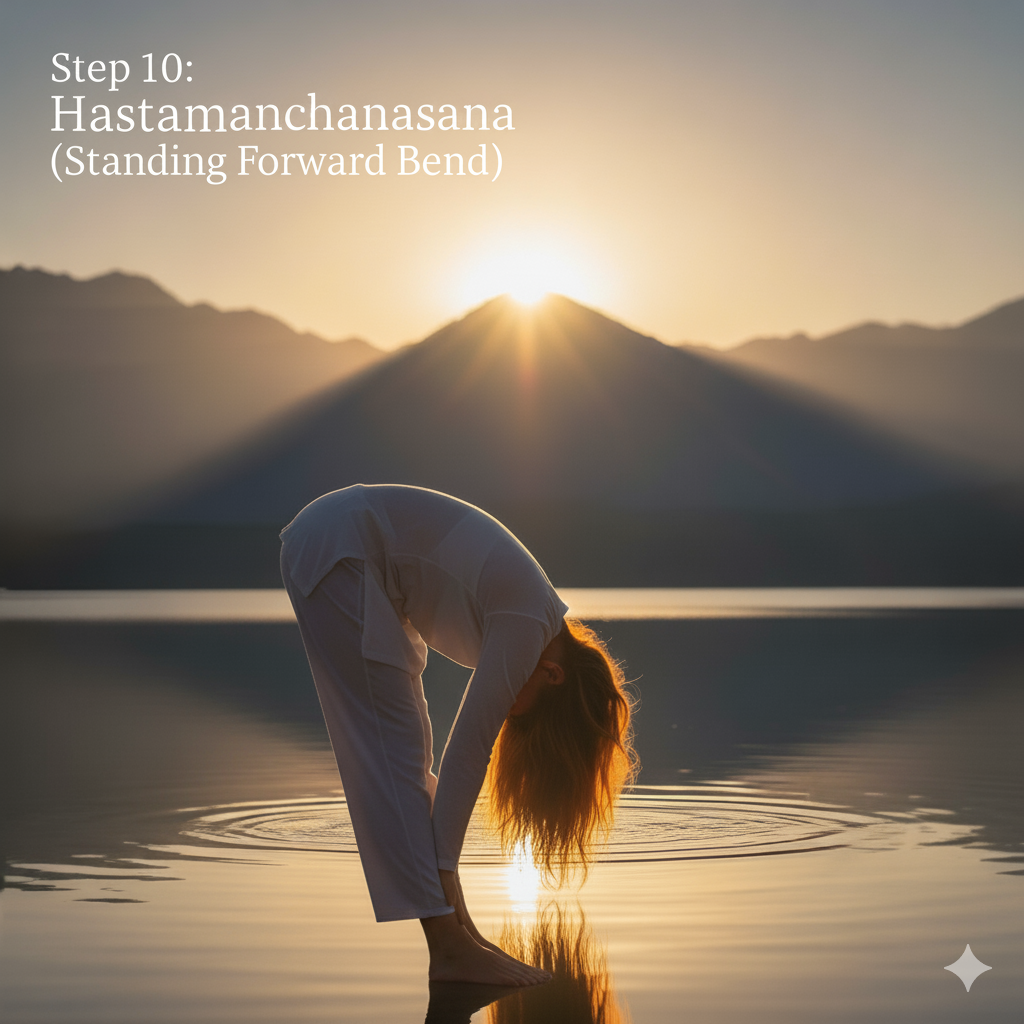
Exhale and bring your left foot forward to meet your right. Straighten your legs and try to touch your head to your knees, keeping your hands on the floor.
11. Hastauttanasana (Raised Arms Pose)
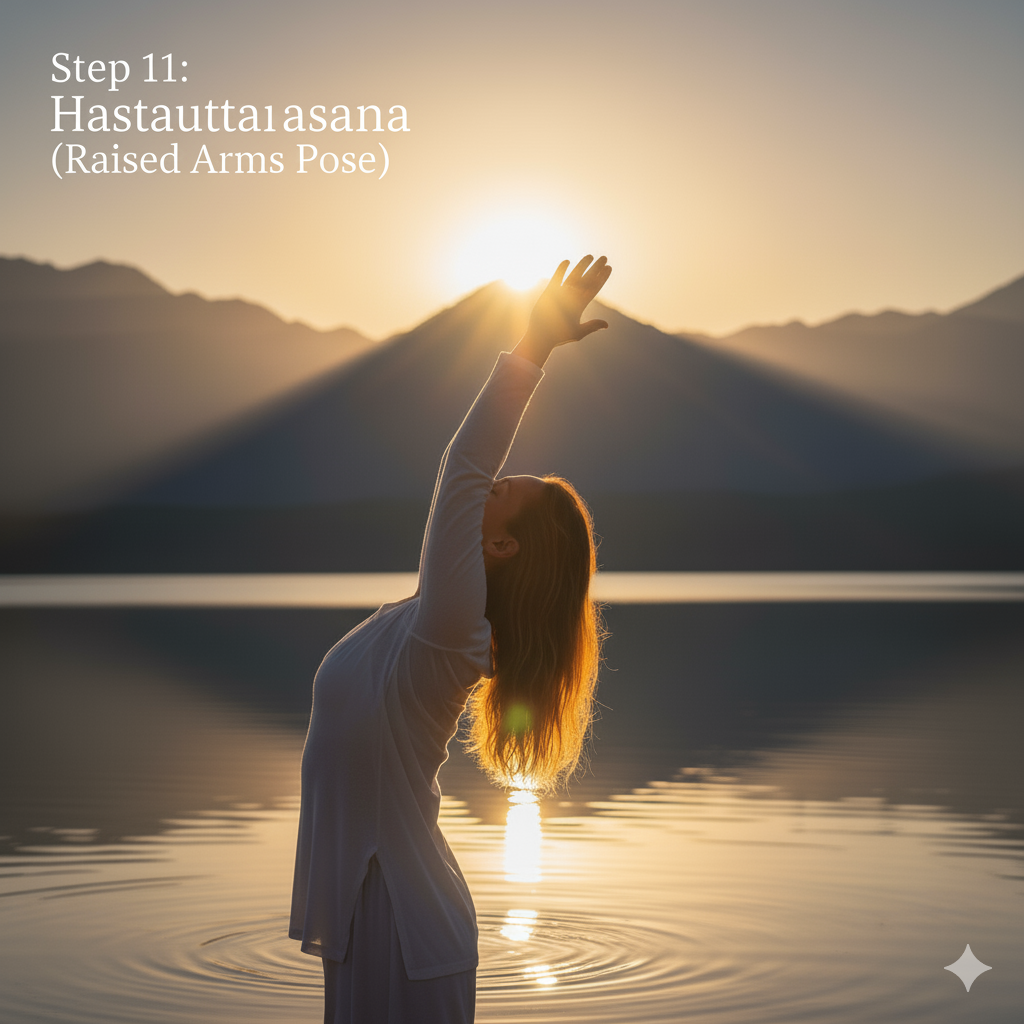
Inhale and rise up, sweeping your arms overhead and back. Arch your spine gently and look up, maintaining the stretch.
12. Pranamasana (Prayer Pose)
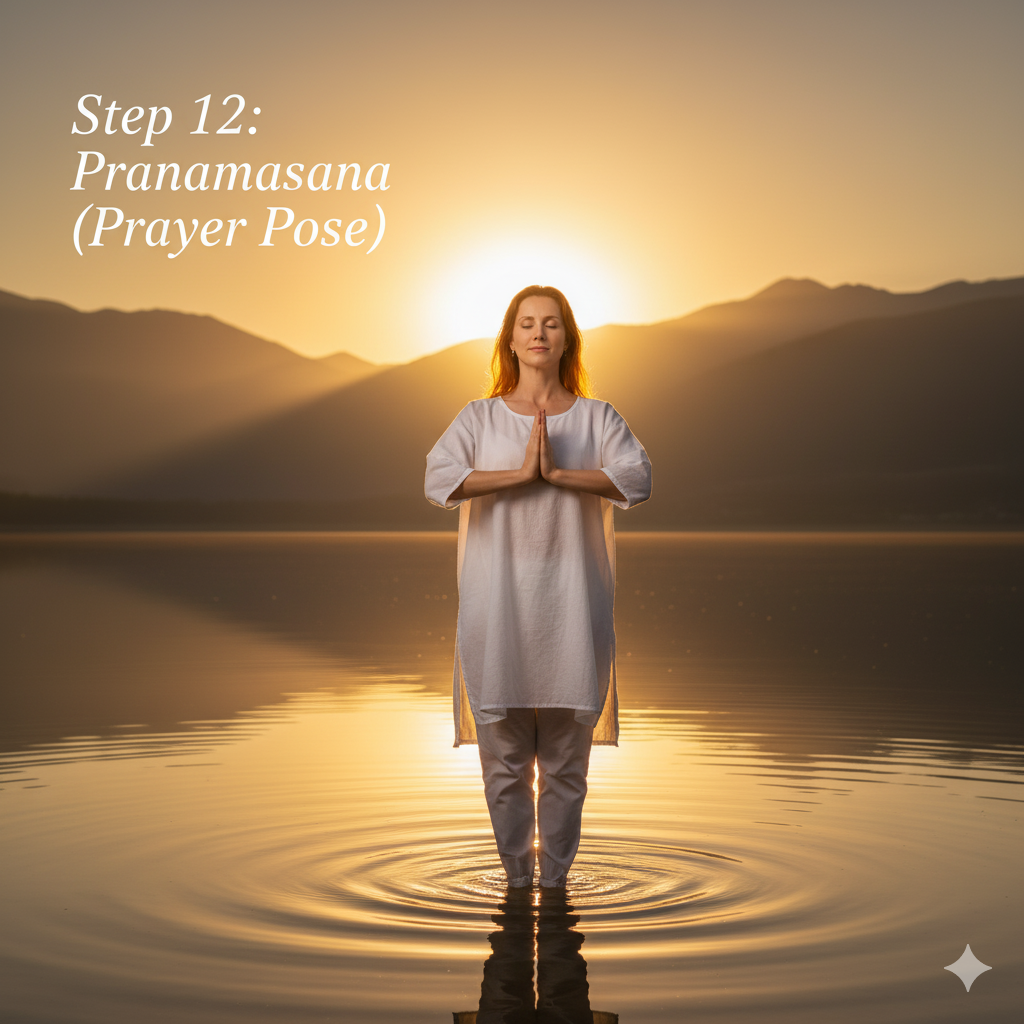
Exhale and return to the starting position with palms together in front of your chest. Relax and prepare for the next round.
This completes one half of Surya Namaskar. To complete a full round, repeat the sequence with the left leg leading in steps 4 and 9.
Breathing Technique in Surya Namaskar
The breath is the bridge between body and mind in Surya Namaskar. Each movement is synchronized with either an inhale or an exhale, creating a rhythmic flow that enhances the practice’s meditative quality.
The general pattern follows this principle: expand and open postures are accompanied by inhalations, while contracting and folding postures coincide with exhalations. This natural breathing pattern oxygenates the blood, calms the nervous system, and helps maintain focus throughout the sequence.
Beginners should never rush the practice. Move at a pace that allows you to maintain deep, controlled breathing. If you find yourself gasping for air, slow down. The breath should always lead the movement, not the other way around.
Physical Benefits of Surya Namaskar
Cardiovascular Health
Performing Surya Namaskar at a moderate to fast pace provides an excellent cardiovascular workout. Multiple rounds can increase heart rate, improve circulation, and strengthen the heart muscle. Regular practice has been shown to help regulate blood pressure and improve overall cardiovascular function.
Weight Management
A dynamic practice of Surya Namaskar burns calories and stimulates metabolism. Depending on the speed and intensity, twelve rounds can burn between 150-200 calories. Combined with a balanced diet, it becomes an effective tool for weight loss and management.
Muscle Strength and Flexibility
The sequence engages virtually every major muscle group in the body. It strengthens the arms, shoulders, back, core, and legs while simultaneously improving flexibility in the spine, hamstrings, and hip flexors. Regular practice creates a lean, toned physique with improved posture.
Digestive System
The alternating stretching and compression of the abdominal region massages internal organs, particularly the digestive system. This stimulation improves digestion, reduces bloating, and can help alleviate constipation.
Respiratory Function
The synchronized breathing practice expands lung capacity and improves oxygen intake. This enhanced respiratory function benefits the entire body, providing more energy and improving endurance.
Hormonal Balance
The various poses in Surya Namaskar stimulate different endocrine glands, helping to regulate hormone production. This can be particularly beneficial for thyroid function, reproductive health, and overall hormonal equilibrium.
Detoxification
The combination of deep breathing and physical movement promotes lymphatic drainage and helps eliminate toxins from the body through increased perspiration and improved circulation.
Mental and Emotional Benefits
Stress Reduction
The meditative quality of Surya Namaskar, combined with focused breathing, activates the parasympathetic nervous system. This triggers the relaxation response, reducing cortisol levels and alleviating stress and anxiety.
Mental Clarity
The practice requires concentration and presence, training the mind to stay focused on the present moment. This mindfulness cultivates mental clarity and improves cognitive function.
Emotional Balance
Regular practice helps regulate mood by balancing neurotransmitter production. Many practitioners report reduced symptoms of depression and anxiety, along with an increased sense of emotional stability and well-being.
Better Sleep
The physical exertion combined with the calming effects on the nervous system can significantly improve sleep quality. Evening practice, performed at a slower pace, can be particularly effective for combating insomnia.
Increased Energy
Despite being physically demanding, Surya Namaskar paradoxically increases energy levels. The practice stimulates the body’s energy centers and improves vitality, leaving practitioners feeling refreshed rather than depleted.
Spiritual Significance
Beyond its physical and mental benefits, Surya Namaskar holds deep spiritual meaning in yogic tradition. The sun represents consciousness, and the practice is seen as a way to awaken the inner light within each practitioner.
Each of the twelve poses corresponds to one of the twelve solar zodiac signs and can be accompanied by specific mantras or affirmations. These mantras honor different aspects of the sun and invoke its qualities of illumination, vitality, and life-giving energy.
The practice serves as a moving meditation, creating a sacred space where practitioners can connect with something greater than themselves. This spiritual dimension transforms Surya Namaskar from mere exercise into a holistic practice that nourishes body, mind, and soul.
How to Start Your Practice
For Beginners
Start slowly with just 2-3 rounds per session. Focus on learning the proper form for each pose rather than speed or quantity. It’s perfectly acceptable to hold poses longer, take breaks between rounds, or modify difficult positions.
Consider watching instructional videos or attending a beginner’s yoga class to ensure you’re performing the poses correctly. Proper alignment is crucial for preventing injury and maximizing benefits.
Building Your Practice
As you become comfortable with the sequence, gradually increase the number of rounds. Many practitioners work up to 12 rounds per session, which takes approximately 15-20 minutes.
You can vary the intensity by adjusting your speed. Slower practice emphasizes flexibility and meditation, while faster sequences provide more cardiovascular benefits.
Best Time to Practice
While Surya Namaskar can be performed at any time, early morning practice on an empty stomach is considered ideal. The quiet hours of dawn provide a peaceful atmosphere for meditation and self-reflection.
Evening practice can also be beneficial, especially if performed at a slower, more relaxed pace. However, avoid vigorous practice right before bed as it may be too energizing.
Common Mistakes to Avoid
Holding Your Breath
Never hold your breath during transitions or difficult poses unless specifically instructed. Continuous, conscious breathing is fundamental to the practice.
Rushing Through Poses
Speed should never compromise form. Each position should be held briefly with awareness before moving to the next.
Incorrect Alignment
Pay attention to alignment cues, especially in poses like Downward Dog and Plank. Poor alignment can lead to strain or injury.
Comparing Yourself to Others
Every body is different. Don’t worry if you can’t achieve the full expression of each pose immediately. Progress comes with consistent practice.
Skipping Warm-Up
While Surya Namaskar itself serves as a warm-up, if your body is particularly stiff or it’s very cold, consider doing some gentle stretches first.
Modifications and Variations
For Limited Flexibility
If you can’t touch the ground in forward bends, bend your knees slightly or use yoga blocks. In Downward Dog, keeping the knees slightly bent is perfectly acceptable.
For Wrist Issues
Perform the sequence on your fists instead of flat palms, or use wrist supports. You can also substitute Dolphin Pose for Downward Dog.
For Back Problems
Modify the backward bends to be gentler, and engage your core muscles to support your lower back. Consider consulting a yoga therapist for personalized modifications.
Advanced Variations
Experienced practitioners can add jumps between poses, hold positions longer, or incorporate more challenging variations of individual poses.
Complementary Practices
Surya Namaskar integrates beautifully with other yoga practices. Consider adding pranayama (breathing exercises) before your practice to deepen your breath awareness, or meditation afterward to extend the sense of peace and clarity.
Combining Surya Namaskar with other asanas creates a well-rounded yoga routine. Follow your Sun Salutations with standing poses, twists, or restorative poses for a complete practice.
Precautions and Contraindications
While Surya Namaskar is generally safe for most people, certain conditions require caution or modifications:
- Pregnant women should modify or avoid certain poses, especially after the first trimester
- Those with high blood pressure should avoid or modify inversions
- People with back injuries should practice under professional guidance
- Avoid practice during menstruation if it causes discomfort
- Those with wrist, shoulder, or knee injuries should modify accordingly
- Consult a healthcare provider if you have any chronic health conditions
Conclusion
Surya Namaskar is far more than a simple exercise routine. It’s a complete practice that harmonizes body, breath, and mind while honoring the source of all life on Earth. The beauty of Sun Salutation lies in its accessibility—it requires no special equipment, minimal space, and can be adapted to any fitness level.
Whether you practice for physical fitness, mental clarity, emotional balance, or spiritual growth, Surya Namaskar offers a pathway to holistic wellbeing. The key is consistency rather than perfection. Even just a few rounds daily can create profound changes in your health and consciousness.
As you develop your practice, you’ll discover that Surya Namaskar becomes more than something you do—it becomes a moving meditation, a daily ritual, and a celebration of life itself. Step onto your mat, face the sun (literally or metaphorically), and begin your journey toward radiant health and inner peace.
The ancient wisdom of Surya Namaskar is as relevant today as it was thousands of years ago. In our modern world of stress and disconnection, this timeless practice offers a way back to ourselves, to balance, and to the fundamental energy that sustains all life. Embrace the practice, honor the process, and let the sun within you shine.
